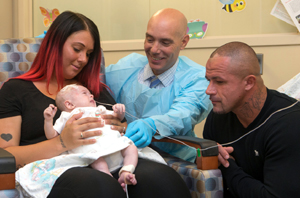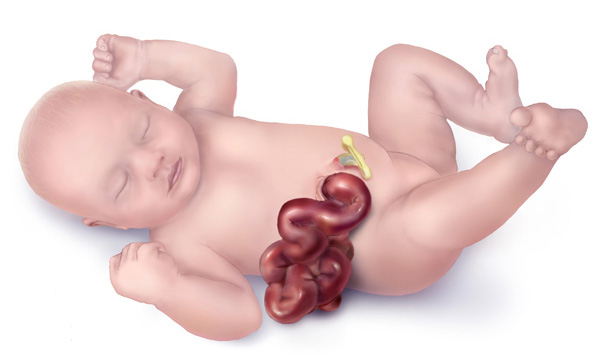
| Baby Christian Rojas with his mother and father and Dr. Christopher S. Muratore (center) yesterday at Stony Brook Children's Hospital. |
Christian Rojas, of Port Jefferson Station, was born at Stony Brook Children's Hospital on May 5th at 35 weeks with a life-threatening condition of the abdominal (belly) wall called gastroschisis (pronounced gas-TRAHS-ki-sis).
Through a series of operations, Christopher S. Muratore, MD, chief of pediatric surgery, and his team at Stony Brook Children's Hospital, were able to save the baby, untwist the bowel, and rescue him in time.
Now the baby is being prepared to go home soon from the hospital.
Christian weighed in at a low birth weight of 5 pounds 7 ounces but is now nearly 11 pounds and hitting some key targets. More good news!
Gastroschisis is a birth defect of the abdominal wall. The baby's intestines are found outside of its body, exiting through a hole beside the belly button. The hole can be small or large and sometimes other organs, such as the stomach and liver, can also be found outside of the baby's body.
Gastroschisis requires surgical repair soon after birth, and is associated with an increased risk for medical complications and mortality during infancy.

| Baby with gastroschisis (illustration courtesy of the Centers for Disease Control and Prevention, National Center on Birth Defects and Developmental Disabilities). |
The Centers for Disease Control and Prevention (CDC) estimates that about 1,871 babies are born each year in the United States with gastroschisis, but several studies show that recently this birth defect has become more common, particularly among younger mothers.
CDC researchers recently found that over 18 years, the prevalence of gastroschisis more than doubled in the United States. More research is needed to understand what is causing the increase.
The Newsday article, written by Delthia Ricks, highlights Dr. Muratore's description of the baby's case as "extraordinarily complicated and marked by an extreme twist in the bowel, a condition called midgut volvulus; the contortion threatened the bowel's blood supply."
"Many babies with gastroschisis will suffer the consequence of intestinal failure," Dr. Muratore is quoted as saying. Soon after Christian was born, Dr. Muratore and his pediatric surgery team embarked on a series of surgeries to save the baby's life.
"When we recognized the intestine was twisted, we did what we needed to do to untwist it," he explains. He worked closely with a team of five surgeons, 10 neonatologists — newborn care specialists — and a squad of nurses. Christian has been monitored around the clock since arriving in Stony Brook Children's neonatal intensive care unit (NICU).
Dr. Muratore points out that he and his Stony Brook colleagues have seen a number of babies in our area with gastroschisis. Stony Brook Children's treats about 10 cases of it annually.
| Outcomes in gastroschisis have changed dramatically in the past four decades, with the advent of improved neonatal intensive care unit, surgical, obstetric, and nutritional care. Overall, survival went from 50% to 60% in the 1960s to greater than 90% currently.… The improved survival and diminished morbidity from gastroschisis may be noted from the fact that up to 60% of children will report psychological stress at the absence of a normal umbilicus, and this may be the most prevalent long-term issue requiring reconstruction in some cases. — "Advances in Surgery for Abdominal Wall Defects," Clinics in Perinatology (2012) |


